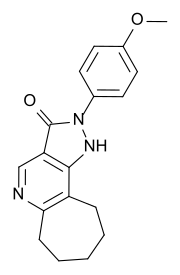CGS-20625
CGS-20625 is an anxiolytic drug used in scientific research. It has similar effects to benzodiazepine drugs,[1] but is structurally distinct and so is classed as a nonbenzodiazepine anxiolytic.[2][3] It produces anxiolytic and anticonvulsant effects, but with no sedative effects even at high doses, and no significant muscle relaxant effects.[4] It is orally active in humans, but with relatively low bioavailability.[5]
 | |
| Clinical data | |
|---|---|
| Routes of administration | oral |
| ATC code |
|
| Pharmacokinetic data | |
| Bioavailability | 41% |
| Identifiers | |
| |
| CAS Number | |
| PubChem CID | |
| ChemSpider | |
| UNII | |
| CompTox Dashboard (EPA) | |
| Chemical and physical data | |
| Formula | C18H19N3O2 |
| Molar mass | 309.369 g·mol−1 |
| 3D model (JSmol) | |
| |
| |
| | |
CGS-20625 is a positive allosteric modulator at several GABAA receptors types. Due to its alicyclic moiety potency at γ1 subunit containing receptor types is more pronounced for CGS-20625 compared to benzodiazepines.[1] γ1 subunits are expressed at higher levels in the central amygdala.[6]
References
- Khom S, Baburin I, Timin EN, Hohaus A, Sieghart W, Hering S (Feb 2006). "Pharmacological properties of GABAA receptors containing gamma1 subunits". Mol. Pharmacol. 69 (2): 640–9. doi:10.1124/mol.105.017236. PMID 16272224. S2CID 15082432.
- Bennett DA (1987). "Pharmacology of the pyrazolo-type compounds: agonist, antagonist and inverse agonist actions". Physiol. Behav. 41 (3): 241–5. doi:10.1016/0031-9384(87)90360-X. PMID 2893398.
- Brunner LA, Luders RC (Aug 1991). "Determination of a potential anxiolytic drug (CGS 20625) in human plasma by high-performance liquid chromatography". J. Chromatogr. 568 (2): 487–93. doi:10.1016/0378-4347(91)80188-I. PMID 1686029.
- Williams M, Bennett DA, Loo PS, et al. (Jan 1989). "CGS 20625, a novel pyrazolopyridine anxiolytic". J Pharmacol Exp Ther. 248 (1): 89–96. PMID 2563294.
- Hirschberg Y, Oberle RL, Ortiz M, Lau H, Markowska M (Feb 1995). "Oral absorption of CGS-20625, an insoluble drug, in dogs and man". J Pharmacokinet Biopharm. 23 (1): 11–23. doi:10.1007/BF02353783. PMID 8576841.
- Esmaeili A, Lynch JW, Sah P (January 2009). "GABAA receptors containing gamma1 subunits contribute to inhibitory transmission in the central amygdala". J. Neurophysiol. 101 (1): 341–9. doi:10.1152/jn.90991.2008. PMID 19004994. S2CID 1590604.
This article is issued from Wikipedia. The text is licensed under Creative Commons - Attribution - Sharealike. Additional terms may apply for the media files.